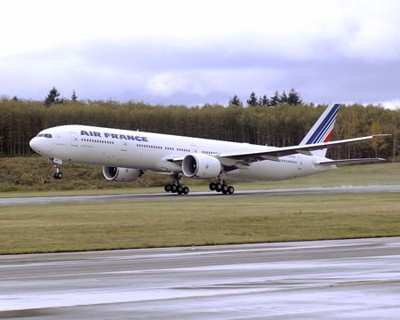Fri, Oct 31, 2014
New Market Report Projects Annual U.S. Growth Of Over Seven Percent
Despite growth in the market shares of low-cost carriers (LCCs), full-service airlines posted strong growth over the next four years, according to research released by ReportsnReports.

With the exception of Japan, the world's 10 leading full-service airline markets posted strong growth: the US posted a CAGR (Compound Annual Growth Rate) of 7.23%, while Russia rose by 28.39%. Both China and the UAE expanded by 18.31%, while Singapore recorded a growth of 10.34%. Key markets in Europe recorded moderate growth due to the eurozone crisis, while Japan and more developed economies in Europe such as Spain were the worst affected by LCCs. This report provides an extensive analysis of the global full-service airlines market, including: The full-service airline market sizes for 40 countries for 2009-2013, and forecast figures for 2014-2018 as well as Full-service airlines' key performance indicators in these countries, with values for both the 2009-2013 review period and the 2014-2018 forecast period.
The Global Full-Service Airline Market to 2018 research report says that a key concern facing full-service airline operators is the unprecedented growth and success of low-cost carriers (LCCs) during the review period. The economic slowdown adversely impacted customer confidence, leading them to look for a cheaper means of travel. The popularity of LCCs has forced many full-service airlines to launch subsidiaries, offering flights with limited services. More than $40 billion in ancillary fees (or fees from non-ticket sources) was collected worldwide in 2013. Full-service airlines recorded $15.1 billion in ancillary revenue in 2013, an increase of 18.0% over 2012. The US aviation market has been in a period of consolidation since 2008, the latest merger was between American Airlines and US Airways in 2013. Consolidation has resulted in market concentration, with the three leading full-service carriers, American, United and Delta, collectively accounting for 75% of traffic. Consolidation has also
resulted in a slowdown in capacity growth as the newly merged airlines realigned their capacity to increase profitability.

In the full service airline markets such as China and Japan, LCCs have entered lately and have therefore not caused major damage to full-service carriers. Full service carriers accounted for 84.3% of the airlines revenues in Japan in 2013, while it represented a share of 94.7% in China. However, over the forecast period, the share of full-service carriers in Japan and China is expected to decrease to 80.1% and 93.2%, respectively. Leading European full-service airlines which were badly hit by the region's poor economic conditions showed signs of improvement in 2013. Air France-KLM, which registered operating losses of $482.0 million in 2012, recorded operating profits of $180.2 million in 2013. From a loss of $31.4 million in 2012, International Airlines Group (IAG) recorded profit of $1.1 billion in 2013. These encouraging results are primarily due to their cost-cutting efforts and the restructuring of flight operations to focus on important international routes. Rising demand for air travel will
primarily drive the growth of full-service airlines in the Middle East. Central hubs of the region facilitate airlines to serve several routes that have inadequate traffic. Alliances and equity stakes in carriers from neighboring regions will nourish the region's hubs. Etihad acquired a 49% stake in Alitalia in 2014, Emirates formed an alliance with Qantas in 2012, Etihad signed a codeshare agreement with Air France-KLM Group and Air Berlin in 2012 and Qatar Airways joined the oneworld alliance in 2013.
(Images from file)
More News
Airbus Racer Demonstrator Makes Inaugural Flight Airbus Helicopters' ambitious Racer demonstrator has achieved its inaugural flight as part of the Clean Sky 2 initiative, a corners>[...]
A little Bit Quieter, Said Testers, But in the End it's Still a DA40 Diamond Aircraft recently completed a little pilot project with Lufthansa Aviation Training, putting a pair of >[...]
Line Up And Wait (LUAW) Used by ATC to inform a pilot to taxi onto the departure runway to line up and wait. It is not authorization for takeoff. It is used when takeoff clearance >[...]
Contributing To The Accident Was The Pilot’s Use Of Methamphetamine... Analysis: The pilot departed on a local flight to perform low-altitude maneuvers in a nearby desert val>[...]
From 2015 (YouTube Version): Overcoming Obstacles To Achieve Their Dreams… At EAA AirVenture 2015, FedEx arrived with one of their Airbus freight-hauling aircraft and placed>[...]
 Airbus Racer Helicopter Demonstrator First Flight Part of Clean Sky 2 Initiative
Airbus Racer Helicopter Demonstrator First Flight Part of Clean Sky 2 Initiative Diamond's Electric DA40 Finds Fans at Dübendorf
Diamond's Electric DA40 Finds Fans at Dübendorf ANN's Daily Aero-Term (04.23.24): Line Up And Wait (LUAW)
ANN's Daily Aero-Term (04.23.24): Line Up And Wait (LUAW) NTSB Final Report: Extra Flugzeugbau GMBH EA300/L
NTSB Final Report: Extra Flugzeugbau GMBH EA300/L Classic Aero-TV: 'Never Give Up' - Advice From Two of FedEx's Female Captains
Classic Aero-TV: 'Never Give Up' - Advice From Two of FedEx's Female Captains




